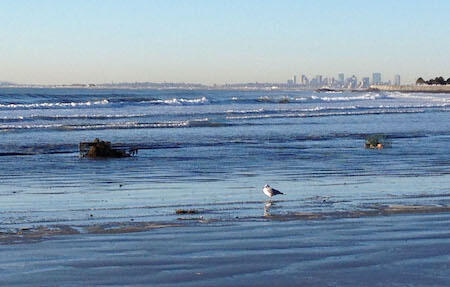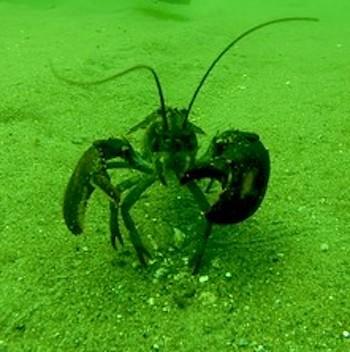Massachusetts has a rich relationship with the American lobster (Homarus americanus)—from its origins as a cheap source of sustenance for servants and prisoners to fetching a pretty penny as a highly desirable entrée, lobster has been fished in the Bay State since Native American and Colonial times. The primary method of catching lobsters is by lobster pots (since the good old days of collecting the masses that wash up on shore are long gone). This gear—being subject to the elements of the ocean—can become lost, abandoned, or damaged and cause unintended impacts to the marine environment. This CZ-Tip provides information on lobster gear as marine debris; efforts from industry, resource managers, and private companies to address the problem; and what you can do to help.
Lobster Gear as a Source of Marine Debris
In 2015, roughly 325,000 pots were set in Massachusetts coastal waters and 16.3 million pounds of lobster were landed. With all that gear catching all that lobster, it is inevitable that some pots becomes lost—whether by storms and currents, snagging on the ocean bottom, entanglements with other vessels, or wear and tear over time. Regulations that require lobster pot lines to have “weak links” (lines that are allowed to break free when encountered by a whale) and mandatory sinking ground lines (lines that rest on the bottom and are at greater risk of abrasion) have been very successful in protecting whales from entanglement, but can also make it easier for gear to be lost in the ocean. Lost fishing gear is known as “ghost gear” because it can continue to catch fish and wildlife that are not retrieved or released. Lost gear can also damage habitats, contribute to the trash floating in the ocean (aka “marine debris”), and act as a hazard by damaging boat hulls and becoming wrapped around propellers and even active fishing gear. The issue is more prevalent now that the materials used to make lobster pots have become more durable (steel and plastic are typically replacing wood and cotton), preventing the breakdown of the gear and allowing it to linger longer.
Efforts to Reduce Lost Lobster Gear
To prevent ghost fishing and other impacts of lost gear, the lobster industry, resource managers, private companies, and others have been working to improve gear design and actively remove lost gear from the oceans and shores. The following efforts are helping to protect marine resources while supporting local fishing communities and industries:
- Fishing for Energy Partnership - The Fishing for Energy program is a partnership between lobstermen/fishermen, the National Oceanic and Atmospheric Administration (NOAA) Marine Debris Program, National Fish and Wildlife Foundation (NFWF), Schnitzer Steel Industries, and Covanta Energy Corporation to prevent and reduce the impacts of lost fishing gear in the marine environment. NFWF works with NOAA to help identify priority ports for the disposal of lost fishing gear, fishermen dispose of the gear (for free) in designated dumpsters, and Schnitzer Steel extracts any metals and then shears and ships the remaining gear to a Covanta Energy facility where it is incinerated and turned into renewable energy. In Massachusetts, several communities host bins used to collect old, unused, and lost fishing gear. Not only does this make proper disposal easier for commercial fishermen, it helps ensure that lost gear that is still in good working condition is returned to its owner based on identification tags. For more on this innovative program, see the NFWF Fishing for Energy web page or their downloadable fact sheet (PDF, 386 KB). For information on collection locations, contact Kaity Goldsmith at kaitlin.goldsmith@nfwf.org.
- Lobster and Fishing Industry Efforts -To promote a sustainable fishery, the commercial fishing industry of Massachusetts has been working collectively and independently for years to help clean up lost fishing gear and design methods to minimize the impact of fishing gear on natural resources. To accomplish this, lobstermen often work with the following groups:
- The Massachusetts Lobstermen’s Association (MLA), founded in 1963, provides input and insight into gear requirements and participates in the Fishing for Energy program. Together with the commercial fishing industry, they are actively involved in recovery and disposal efforts and local beach cleanups to remove and minimize the impacts of marine debris from the shoreline. For their monthly newsletter, current events, and updates on fishery research and management, see the MLA website.
- Since the 1970s, the Atlantic Offshore Lobstermen’s Association (AOLA) has supported research activities to increase the knowledge and awareness of the lobster resource and issues relating to the lobster industry. AOLA has actively been involved in research aimed to reduce gear impacts, such as sinking rope field tests and escape vent projects.
- Gear Requirements- State and federal regulations are now in place to help reduce the potential of ghost fishing by lobster pots. These rules require specific features, such as escape vents (that allow smaller juvenile lobsters to escape) and ghost panels (the use of biodegradable material on a panel door that allows fish and lobsters to escape over time). See the Massachusetts Division of Marine Fisheries (MarineFisheries) Lobster/Crab Trap Requirements web page for details.
- Research and Planning - The lobster industry, researchers, and government agencies are continuing to look into ways to reduce lost gear and its likelihood of ghost fishing. Ideas include enhancing gear design to avoid snagging the bottom, increasing navigational awareness of gear in the water, and improving the biodegradable components of gear (see the “Microbe Escape Panels” textbox for one creative initiative). Efforts are also underway to enhance the recovery of gear, such as through the use of GPS and sonar to provide fishermen with precise location information. For more research efforts, see the Fishing for Energy Fund Project Summaries for 2009-2015 (PDF, 674 KB), 2018 (PDF, 1.9 MB), and 2019 (PDF, 1.7 MB), or NOAA’s Northeast Fisheries Science Center Lobster Science and Data page.
Microbe Escape Panels - A study at the Virginia Institute of Marine Science (VIMS) has discovered a way to create an escape vent made of biodegradable materials that can be broken down by marine microbes, providing an avenue for escape when the pots are left in the water for extended periods. In the dark ocean waters, bacteria grow on this biodegradable material and consume the panels. When pots are exposed to UV light during active fishing, however, the growth of the bacteria is hindered and the panels last longer. See the VIMS Marine Debris Project: Biodegradable Cull Panels web page for more information.
What You Can Do
These options can also help you become part of the solution for preventing marine debris:
- Coastal Cleanup Efforts - Whether you are part of the fishing industry or a concerned citizen, a great way to help is to participate in one of the many beach cleanups that take place along the shore each year, including the statewide COASTSWEEP beach cleanup sponsored by the Massachusetts Office of Coastal Zone Management (CZM). With COASTSWEEP, the lost fishing gear, trash, and other items you might find are recorded and later analyzed to help identify sources of marine debris and develop education and policy initiatives to help reduce it.
- Fishing Gear - If you find intact fishing gear (such as lobster pots or buoys), or fragments of fishing gear that contain identification numbers, do not remove the gear. Instead, note any identification numbers and report them to the Massachusetts Environmental Police (MEP) Dispatcher at (617) 626-1650. If you find fishing gear debris with no identification number that is clearly damaged beyond use as fishing gear (examples include fragments of gear, frayed rope, or a rusted wire trap that is smashed beyond salvage), such debris may be removed and disposed of or recycled. If you are in doubt about whether fishing gear debris is salvageable for use in fishing, contact MEP as described above.
Additional Information on the American Lobster and Marine Debris
- NOAA’s Impact of “Ghost Fishing” via Derelict Fishing Gear provides information on ghost fishing and its impacts on fish and wildlife and the fishing industry.
- The American Lobster profile page on NOAA’s FishWatch: U.S. Seafood Facts website provides information on lobster populations, fishing rates, habitat impacts, research projects, and other lobster facts.
- The MarineFisheries Commercial Lobster & Crab Regulations and Recreational Saltwater Fishing Regulations provide permit requirements, including catch size, catch limits, gear restrictions, and rules on the catching of egg-bearing and v-notched lobsters. See the MarineFisheries Advisories page for current regulations affecting commercial and recreational pot gear fishermen, including rules about the Massachusetts Large Whale Seasonal Trap Gear Closure Area and other requirements around Cape Cod.
- The MarineFisheries Massachusetts Saltwater Recreational Fishing Guide (specifically, search for “Lobster and Crabbing” ) offers a compilation of recreational lobster permit information, including gear rules and how to measure lobsters for legal catch.
- For detailed information about other sources of marine debris and how you can help clean the shores of this trash or even reuse a few items, see CZM’s COASTSWEEP - More on Marine Debris and this CZ-Tip: Repurposing with a Purpose.
Lobster Facts
- Young lobsters hide in seaweeds and rocky habitats near the shore where they are able to escape predators and find food. Larger adult lobsters are more migratory, inhabiting warmer coastal waters in the summer, but heading to deeper waters in the winter to avoid turbulence.
- When not chasing baited traps, lobsters tend to pursue fresh food, including fish, clams, mussels, crabs, sea urchins, and even other lobsters. The food that gets consumed immediately heads to the lobster’s stomach, where it gets “chewed” with a grinding structure called a gastric mill.
- A lobster can discard a limb to escape a predator (a lobster with one missing claw is called a cull; two missing claws is a bullet). The good news is that a lobster is able to regenerate that missing claw (and even a leg or antennae)—though a one-pound lobster may take five years to regenerate an appropriately sized claw.
- Supposedly, the brain of a lobster is the size of a pea and the nervous system is so simple that it does not process pain.
- A female lobster lays a couple thousand eggs when she is young and tens of thousands of eggs as she matures, but only about 1 lobster out of 10,000 eggs will reach adulthood.
- Until recently, there was no precise way to determine a lobster’s age, although they were thought to live for more than 100 years. Scientists have now found that counting the rings on a lobster's eye stalks can reveal its age. See this Smithsonian Magazine Smart News segment for more.
- The green part of a cooked lobster (tomalley) is a digestive gland that acts like an intestine, liver, and pancreas—accumulating contaminants from the environment. Because of the potential toxins, the U.S. Food and Drug Administration and the Massachusetts Department of Public Health have advised consumers to refrain from eating the tomalley (see A Guide to Eating Fish Safely in Massachusetts).

